Feeding Your Labrador Puppy: How Much, Diet Charts And The Best Food
The food you give your Labrador puppy, together with choosing the right portions and schedules, will help ensure their optimum growth, development and health. Puppy kibble, raw food, wet canned meals and homemade Labrador diets all have different benefits.
The amounts of protein, fat, carbohydrates, vitamins and minerals vary even between brands of the same type of puppy food. Your small puppy needs to eat regular small nutritious meals. Feed your Lab puppy four times a day, to begin with, evenly spread out over daytime hours. Our Labrador feeding chart by age will help you adjust as your puppy grows up.
- How much to feed a Lab puppy
- Labrador feeding chart by age
- Best puppy food for your Lab
- Feeding your puppy on kibble
- Raw diets
- How often and what time to feed
*The products linked in this article were carefully selected by The Labrador Site. If you decide to purchase using the links provided, we may earn a small commission on that sale. This is at no extra cost to you.
I will show you the best puppy foods, whether dry, wet, or raw, and look at food safety, together with schedules, quantities and even a handy puppy diet chart. Finally, I’ll include some reviews of the various brands, and will help you cope with the all-important transition to feeding an adult dog.
Ways of Feeding Your Labrador Puppy
The main Labrador puppy food types are:
- Puppy kibble dried food
- BARF or raw feed
- Wet food in cans or pouches
- Home cooked puppy food
Experts Disagree on Puppy Feeding
Experts disagree on the best way to feed your puppy. People often feel very strongly that one way of feeding is better than another, and you can always find evidence to support your view. Dog breeders, veterinarians and even nutritionists have their own strong views. The dire consequences they list for not listening to them can have puppy owners very worried.
The truth is that there is no good quality evidence showing that kibble is better for the long term health of your dog, or that raw feeding is better. There are risks and benefits to both, and the main thing is to ensure that your dog has good quality food to eat.
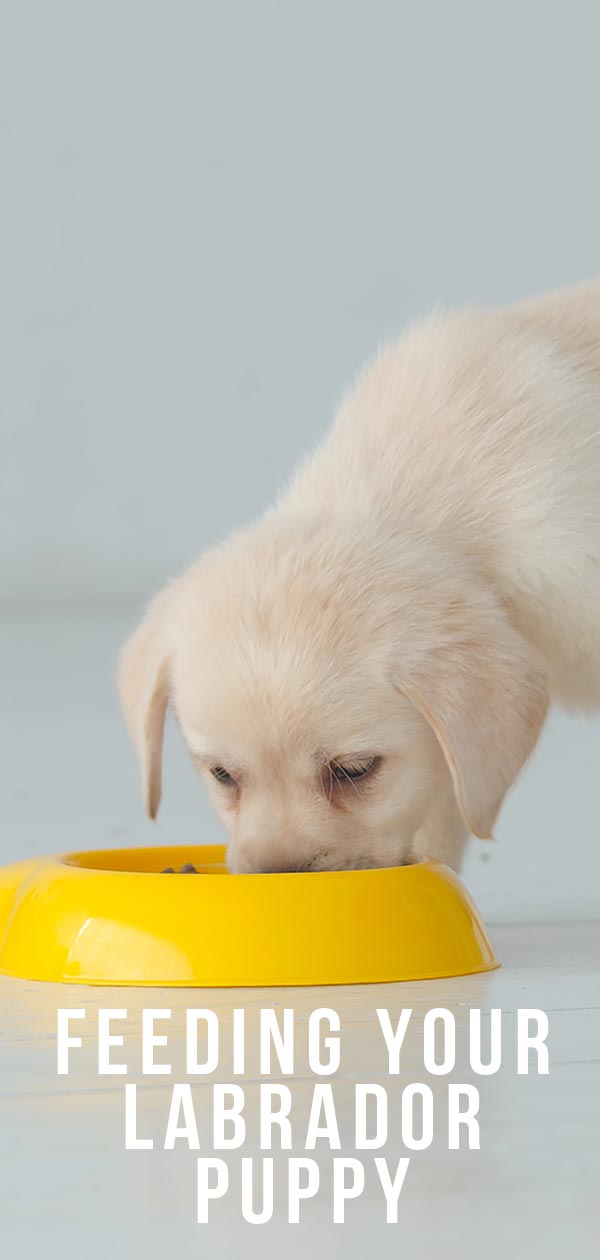
Choosing The Best Puppy Food For Labs
Different puppy feeding suit different families. Puppy kibble suits some better, and raw puppy food is better for others.
If like most people, you’ll be feeding your Labrador puppy on commercial dry puppy food, you should not feel that you are letting him down in any way.
Puppy Kibble for your Labrador
Good puppy kibble(paid link)* will contain all the nutrients your Labrador puppy needs in order to grow and remain healthy. Puppy kibble stores well provided that you don’t get the food become damp. An airtight plastic container or tin will do the job, although you should make sure it is food grade quality.
Most breeders start their puppies off on kibble and your veterinarian is most likely to support this method of feeding.
What Other Food Should You Feed With Puppy Kibble?
Labrador puppy kibble only needs to be fed next to water. Puppy kibble from a reputable manufacturer is intended to be a complete and balanced food. But some owners like to mix in canned dog food or even scraps of raw food with kibble.
Whether you decide to feed only with kibble or you want to mix it up, pick a good dried food manufacturer and stick with them.
What About Feeding Puppies On Raw Food?
Feeding your Labrador puppy raw food has its benefits and drawbacks. One of the downsides is that there is a lot to learn.
Do Plenty of Research
Puppy nutrition research is a huge area you’ll need to dive into to make sure they have a balanced diet during rapid growth. Here is a link to the articles you need to help you decide whether or not raw feeding is for you:
Although I like the raw diet for my dogs, most puppies fed kibble go on to have long and healthy lives. Whatever puppy food you choose, the most important thing is portion control.
How Much to Feed your Labrador Puppy?
People often tell me how much their puppy weighs, and ask how much puppy food they should give him. In fact, one of the most common questions we hear is “how much should I feed my Labrador puppy?”
Labrador puppy food quantities can be measured in weight, but you can also do it by eye. Your puppy’s physical shape is a big giveaway.
Risks Of Overfeeding Your Puppy
Rapid growth doesn’t just put weight on your puppy, but leads to larger but less dense bones and associated skeletal abnormalities. Your Labrador is particularly at risk if they grow too quickly.
The following diet chart is for kibble fed puppies and does not apply to raw fed pups. It gives you an idea of how much to feed your Labrador puppy
Lab Puppy Feeding Chart
The Lab puppy feeding chart below is only a very rough guide. The quantity of food you need for your puppy will vary depending on your puppy and on the brand of food you are feeding him.
Choosing Best Brand of Puppy Food
The best brands of dog food will provide all your puppy’s nutrients and keep him healthy without costing you a small mortgage each week.
It’s important to give your little one food specifically designed for your puppy, because they have different nutritional needs.
Labrador puppy food must be aimed at medium to large breed dogs. Check the pack carefully and look at the dietary charts. Ideally, you want the optimal protein content and the lowest amount of additives.
Part of this always comes down to the cost. The healthiest puppy food is usually the most expensive and may not be affordable for some families.
The Cost Of Puppy Food
Some puppy food brands are more concentrated than and contain a higher proportion of proteins, essential oils, and other nutrients. The cheaper brands may contain more ‘fillers’ in the form of extra carbohydrates, usually made from grain. The absence of these fillers means that you can often feed lower quantities of more costly food, making them less expensive than they first seem.
You might also find that cheaper brands make your puppy poop more due to those extra fillers going straight through him. While some brands are beyond the budget of many families, it is usually good to buy a premium brand.
High Quality Brands of Puppy Food
Some brands of puppy food have developed a reputation for producing a high quality product and have many devoted supporters, including breeders that have fed them to generations of puppies.
One of our favorites is Orijen Large Breed Puppy Formula(paid link).*
Orijen(paid link)* (and some of the other more expensive brands), relies on legumes like lentils and chickpeas as a source of carbs.
These are much gentler on your dog’s stomach than grain, which can cause bowel irritation.
Puppy Food Availability
The big brands are widely available in many parts of the world, and they have a valuable reputation to maintain. So, the chances are, your puppy will be eating a good quality product if you choose one of these.
Your puppy food should give you the manufacturers quantity guidelines for that brand on the packet.
Again, this is a rough guide only, and you should not follow the advice slavishly. Your overfed puppy will be prone to diarrhea, obesity, and too-rapid growth.
Following Puppy Feeding Quantity Guidelines
Just to complicate things, not every puppy in each age group will fall within the weights displayed on the chart above. Some owners may worry that there is something wrong with their puppy. However, don’t worry, because our cuddly Labrador pups vary so much.
Quite simply, puppies of the same age vary in weight and size, so that means the amount of food you need to feed them will be different. Use the guidelines on the packet as a guide, then observe and feel your puppy to check how he is doing. You can always chat to your vet if you have any concerns.
Keeping Your Puppy At The Right Weight
It is important that your dog does not get too fat or too thin. However, you have some leeway, and you should increase or decrease his rations accordingly as he grows.
The most common problem is puppies that get too fat. Although we all love cuddly Labrador puppies, they should not be rotund!
By three months or so, they should have definite waist just like older dogs. Check out this page for more information.
Of course, the other side of the weight issue is puppies that look too thin. That can be another important issue.
What If Your Puppy Is Too Thin?
If you are worried about your puppy’s growth rate it is a good idea to take him along to your vet for check up. Sometimes, it is just a matter of increasing the amount of food or changing the brand to a more nutritious option with fewer fillers.
How Often Should you Feed Your Labrador Puppy?
Like most baby animals, your puppy needs feeding more often than adult dogs. Right now, your puppy’s growth is the fastest it will ever be in his life. He needs plenty of calories to fuel that growth, as well as the right nutrients.
If you feed his entire day’s ration in one go, his digestive system will be overwhelmed and he’ll end up with diarrhea. So, you need to make sure that your puppy’s daily ration of food is broken up into several small meals, fed three to four hours apart.
Feeding your Labrador puppy little and often is a great way of preventing tummy upsets. If your puppy has rather loose stools on three meals a day, try breaking his ration up into four meals a day for a while.
General Guidelines
As a rule of thumb puppies fed on kibble require
- Four meals a day from eight weeks to three months
- Three meals a day from three months to six months
- Two meals a day thereafter
This is all part of getting your puppy used to the feeding routine. Puppies tend to like predictability and feeding at set times.
Mealtimes and Schedules: Or When to Feed Your Puppy
Your puppy’s feeding schedule can fit in with your preferences up to a point. But don’t try and cram all his meals into the evening. If you have to work during the day, you’ll need to make sure someone comes in to feed him.
You can’t just leave your puppy’s food ration for the day down, because he’ll eat it all at once and this may upset his tummy.
First Meal of the Day
Puppies love food, and crave the attention that comes with feeding time. If you’re feeding your Labrador puppy at 6am, because he has woken you and was hungry, the chances are he’ll wake you at 5:45 the following day!
Remember, feeding is a powerful reinforcer of behavior. If you don’t want to encourage your puppy to wake you up earlier each morning, don’t feed him as soon as you get up. Have a coffee and wake up before filling the bowl.
Have a set time for breakfast and don’t feed her before then, even if she has been awake for two hours. She won’t starve in that short period of time, although she might make you feel like she is! Be firm and resist the temptation.
Last Meal Before Bed
Try to space your puppy’s meals out fairly evenly throughout the day. Most importantly, don’t feed your puppy just before you put her to bed for the night.
I like to leave at least a four-hour gap between the puppy’s last meal and her bedtime. This helps to reduce the risk that she will want to use the bathroom at 2 am.
Example Puppy Feeding Schedule
Just to help you on the way, here is an example puppy feeding schedule. Of course, you can adapt this to suit your own routine as long as you pay attention to the above advice.
Feeding schedule for an 8 week old Labrador puppy
My puppy feeding times for 8-week-old puppies tend to be something like this:
- 7am
- 11am
- 3pm
- 7pm
You don’t need to be a slave to the clock, but this is just to give you an idea. A few minutes or even half an hour earlier or later won’t cause problems.
12 Weeks Old
Feeding schedule for a 12 week old Labrador puppy:
- 8am
- 1pm
- 6pm
If you want to make an early start with training your puppy, you can use all or part of his daily rations during training sessions. Again, spread these out throughout the day, and don’t feed too close to bedtime
What If My Puppy Is Still Hungry?
One of the things people most often ask is, “what if my puppy is still hungry?” They have followed the guidelines on the packet, but the food doesn’t seem to be enough to satisfy the puppy.
If your puppy clears up his food in a few seconds and begs for more, don’t panic. This is perfectly common and perfectly normal.
Your puppy doesn’t know for sure when his next meal will be along, so it makes sense to him to eat as much as he possibly can right now!
And, your puppy will be very good at using every trick in the book to win you round.
Stand firm!
What if My Puppy Won’t Eat?
As most experienced Labrador owners know, not all puppies are greedy. And studies have shown that puppies in general eat more when they are fed in a group with other puppies
Your puppy might go off their food for the first few days they spend at home. They eat a few bits of kibble then refuse any more. The puppy may eat from your hand but not their bowl. If your puppy won’t eat at all for more than four hours, then call your vet for advice. Call sooner if the pup is listless or showing any signs of being unwell.
Otherwise, a somewhat reduced appetite, to begin with, is probably nothing to worry about. Just mention it to your vet when you take the pup for his first check up, or in the next day or two.
Changing From Puppy To Adult Food
Puppy kibble manufacturers often recommend feeding your Labrador puppy kibble for puppies up to 12 months of age, before changing to adult kibble.
Some breeders and experienced dog owners do switch their lab puppies on to adult food before this, but not usually before they reach six months of age.
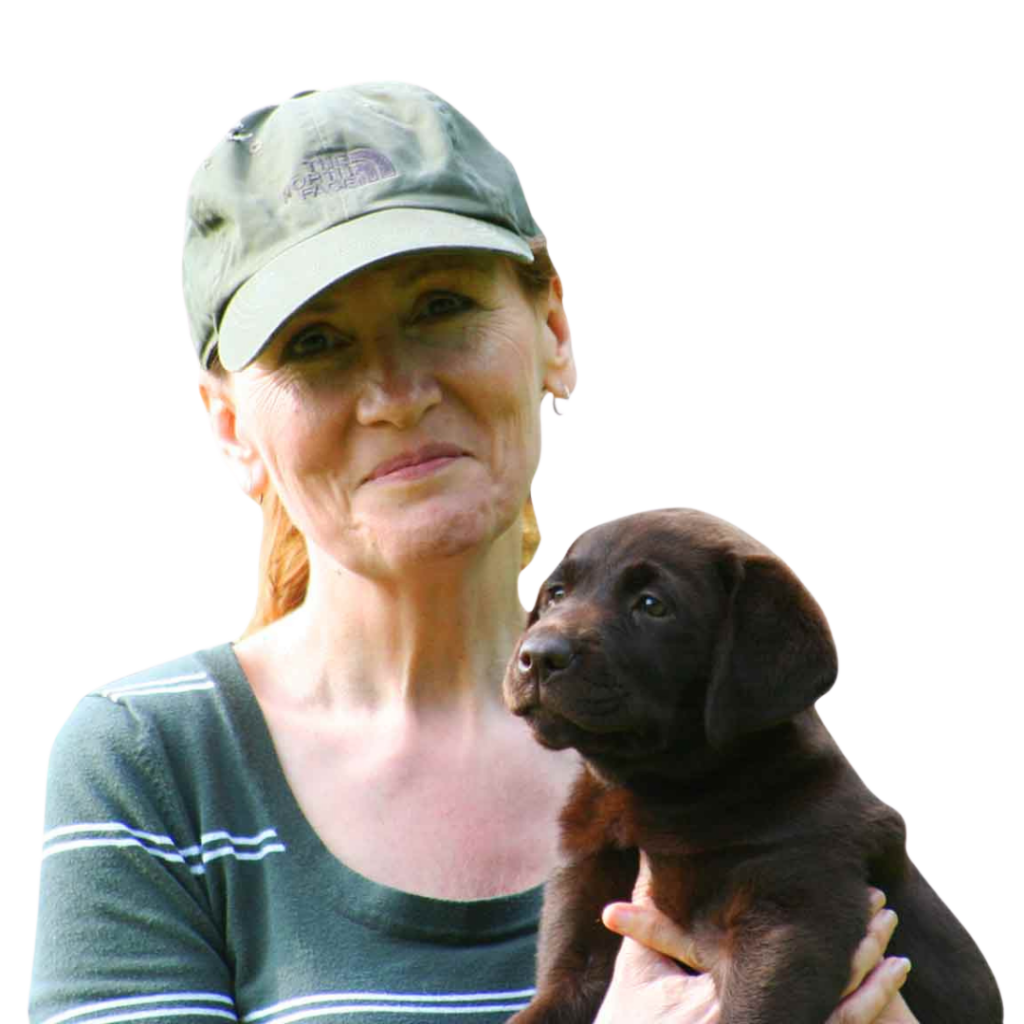
Free Labrador Updates!
Get my training tips, news, reviews, and the latest from The Labrador Site delivered to your inbox
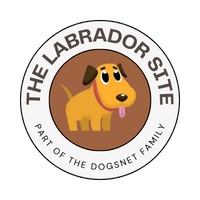
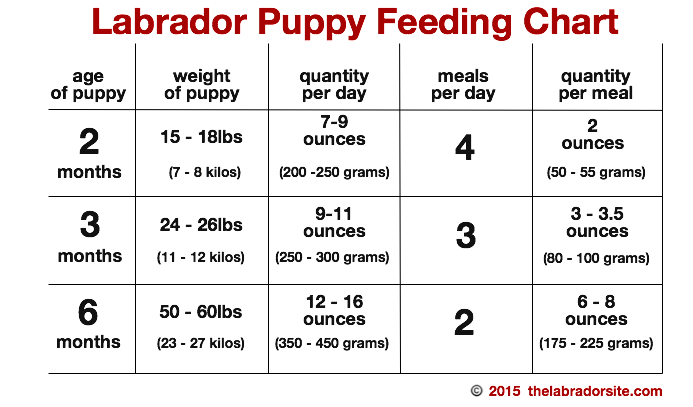
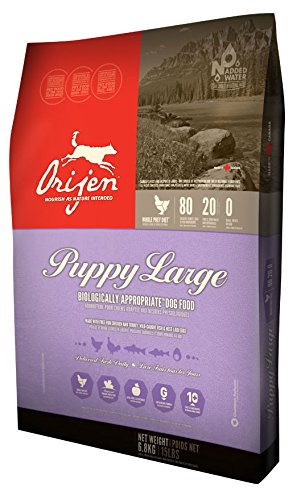
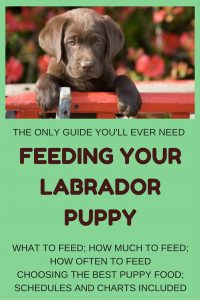
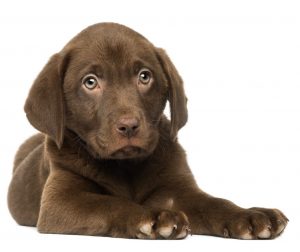
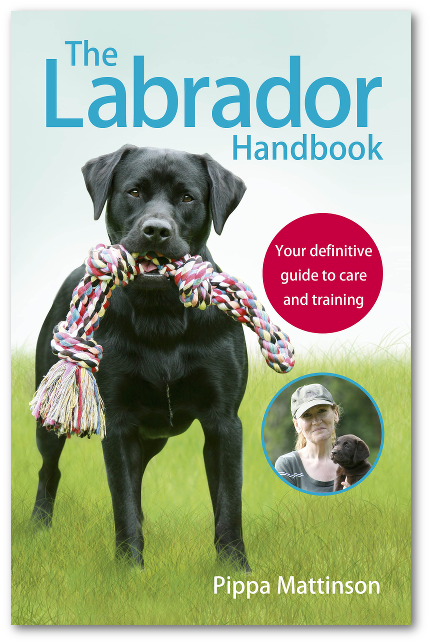
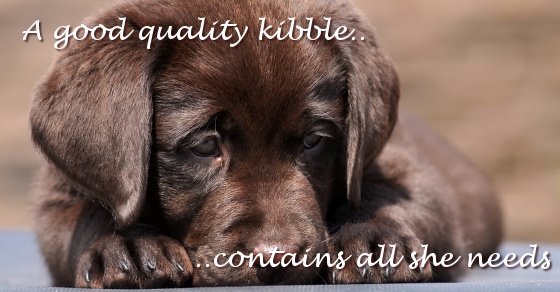

I thought I saw where it said 2-4 cups a day for a 6 month old. I have been feeding her 2 cups in the morning and 2 cups at night. Is that ok?
Hi Patricia, as long as she’s a healthy weight, and otherwise fit and well, then feeding what works well for her is fine. If you’re not sure about her weight, this article has some tips for assessing it: https://www.thelabradorsite.com/fat-labrador/ – and your vet will be able to weigh her and advise you if you’d like more help with this 🙂
I have a Lab/ Pyrenees mix named Lilly that is almost 5 months old. Should I be feeding her in portions? At first, I was doing that but it seemed like she always had to go #2. So I played around with her feeding times, that worked for our schedule, now I feed her before I go to work and she’s on a potty schedule. Lilly gets training treats throughout the day but i feel as if she’s still hungry because she’s always eating whatever she can find in the yard or chewing on something. Any suggestions?
Hi,
I have been feeding my lab pup, Koda, Orijen Large Breed Puppy with amazing grains since he was 3 months old and now he is 8 months young. He seems to be doing very good on it and I personally think the ingredients are the best. But, I do have a question about the high 38% protein, will this effect his growth in the way being too fast. My breeder voiced her concerns about the high protein and said to change his food to a lower protein, around 26%. She thinks he is growing too fast. He is now around 75 pounds. Can you please let me know what your opinion is about the Orijen large breed puppy and the 38% protein. Thank you for your time.
Bill
I’ve always enjoyed my labrador although I had to miss him quite some time in the first years when I was still actively playing in Poker tourneys. Nowadays I usually play online so I can spend way more time with my buddy.
Your article is very informative! Thank you for giving useful tips and providing puppy feeding resources.
nice info thanks for your valuable blog
Hi I have a pit x rottie and when I last weighed him he was 10 weeks old and 14 pounds/…but now hes 14 pounds and looking fairly thin…I often see his ribs when he is standing so its a bit concerning is that good weight or not?
Hi. I just rescued a lab mix, 9 weeks old. I am feeding her Taste of the Wild High Prairie Grain-Free puppy food, and I was just wondering if there are any cons to this food. Also, this article on labs was very informative. The portion control was very helpful. I was looking in the article if any type of occasional treats are good like banana, carrots, strawberries in an extremely small quantity for potty training and good behavior?
Hi Pippa! I recently received a 8 week old puppy (Golden Lab) for Christmas. She is very active and tends to bite at times, we would like to teach her how to sit and be better behaved at times. Please leave me with a link, your reply is apprischiated.
Congratulations on your new puppy! We have an article all about coping with biting here – https://www.thelabradorsite.com/labrador-puppies-biting/
Hello sir/Mam
My labrador retriever is now 7 month older,today i purchase a another Drools maxi puppy diet for him and after that i call my dogs doctor but doctor ask me to buy adult diet for him now.
So i change with adult pack but i didn’t start to feed him till now,
Please reply me fast can i feed him Adult diet or go to change for one more time? ?
I have two 5 month old puppies Lab and Boxer mixed . I want to start feeding them dog food instead of puppy food cause they don’t seem to be satisfied on the puppy chow I feed them a good portion there times a day and the boys weight of 50lbs each at only 5 months old. Should I start the dog food or wait till they are a year old.
Our puppy is now 9 weeks old. Can we start giving her raw carrot or apple? If so, is it best to give carrot in chunky sticks?
She is suffering from Stomach worms.
Its not uncommon for puppies to lose interest in food. You may want to switch up food and definetly lower the intake on snacks. Snacks/treats are great for training. Try purina proplan puppy food or something else with plenty of nutrients. If your going to switch food do it once or twice and re-introduce the previous food along the way.
I have a 8 weeks lab puppy and I feed him pedigree.can I sometimes change the food
Sir I have a Labrador puppy of 3 months .
Sir I want to know that what is the proper diet or food for my lab to be a healthy puppy.
Can you pls also suggest the name of the puppy food…
Hi there I have a lab puppy she is 2 months old she is about 4kg in weight but she has now stopped eating her dinner but still wants her treats when she pees on the mat for her should I stop giving her treats to see if her Apatate comes back again
Hello! I recently switched my 3month black lab onto Lillys Kitchen puppy food as I was given a bag by my friend and her behaviour has become quite strange. I was feeding her Eukanuba lamb and rice before this. So I am trying to gauge if this would have happened anyway. She’s stated waking early again; 30 mins before usual and as soon as she gets up she is preoccupied with food. I have been trying to wait until 8 every morning to feed her which has been fine until the past few days, where it’s become a battle of wits. A battle which continues to each meal time. For example she will ask out for the toilet (because she knows I will let her) and then dash into the kitchen. I have since banned her from the kitchen as she has also resumed (since very early days) jumping up on surfaces to get to food. And hunting about the floor for any ‘leftovers’. I am putting her back onto the Eukanuba for 3 days to see if there is a change, however i was wondering if this related to the diet or is this just behavioral? Can anyone help here or have had similar experiences?? Thank you!!
I have a 4 months old Labrador I brought a pedigree chicken and milk(dry food) but I don’t know how much I feed him a day and the quantity of feeding him a time and is it enough for him ??
Need any helpline no. So that I can contact u.regarding care nd some regular questions.
Hi Nitesh, We don’t provide a helpline I’m afraid, but you can join The Labrador Forum here where experienced owners will be happy offer advice: http://thelabradorforum.com
Hi,l have a 3months lab,i feed him 2 times a day on kibble(Royal canin maxi junior) and 1chicken neck with barly,is this good for him?
How to stop Labrador from bitting habitat???
Here you go Pranav – https://www.thelabradorsite.com/labrador-puppies-biting/
Hi my puppy is 3 months and her weight 5kg is that big problem do I have to take her to vet Dr
Tks
Pippa,
I have a 14 month yellow lab which I have been feeding kibble to since I brought her home at 8 weeks.
I have never been able to get her to eat it all at once, she takes a few bites and then walks around. Now we are feeding her once a day and it takes her about 3-4 hours to finish.
Should I consider changing food?
Hello pippa…my labrador is 8 months old and I don’t know how much and what to feed her..please help.
Hello pippa..my labrador is 8 months old and I don’t know how much and what to feed her..Please help me.
I have a 2 mth old lab puppy,Can I give him cereals for 2 meals and kibble for two meals?
When he is playing he starts growling and becomes aggressive, how am I to handle this situation?He is also into biting habit,how am I to stop this? Kindly let me know.
Hi there, your puppy isn’t being aggressive, he is playing – explanation here: https://www.thelabradorsite.com/help-my-labrador-puppy-is-aggressive/. Information on biting is here: https://www.thelabradorsite.com/labrador-puppies-biting/ feeding instructions in the article above, let us know if there is anything you don’t understand – good luck with your puppy
I have 3 months old Labrador retriever puppy… I give her a ALPO brand of dog food which is the ingredients are meat (Beef) and Vegetables only… I was wondering if its okey too feed her a dog food with Beef??? I dont know were can i buy a dog foods that theres no Beef ingredients ?? Philippines here mostly the dog foods brand here that I surely trusted is Alpo and Pedigree products only… Can you give some advice ??? Thank you Godbless